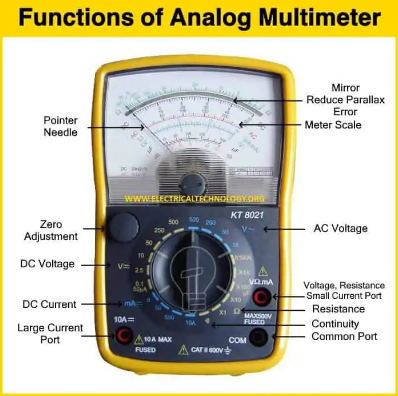Introduction
An electrical multimeter is a vital instrument used to test electrical systems’ volts, amps, and ohms. It is a crucial tool for the electrical and electronics industries because it enables electricians and techs to identify electrical issues, analyze circuitry, and test electrical parts. This gadget usually has a digital display for precise readings and is handheld. It comes in many sizes, shapes, and features to meet various requirements.
Main body
It is important to note that analog and digital electrical multimeters are accessible. Technology shows how digital multimeters use an LCD or LED screen to show the measurements, while analog multimeters use mechanical movement. Because they are simpler to understand and provide more accurate measurements, digital multimeters are growing increasingly common. Some digital multimeters also come with extra features, like the capacity to measure temperature or a data logging tool. Some multimeters are also made for particular uses, like HVAC or automobile systems. These multimeters might have extra capabilities or add-ons specially designed for those sectors’ requirements. To guarantee accurate readings and safe operation, selecting the appropriate multimeter for the task is crucial.
Display screen: The multimeter’s display panel, which is its most noticeable feature, is where the readings are displayed. Typically, it has an LCD showing various measurements, including voltage, current, resistance, and continuity. The screen’s size can vary depending on the make and model, but it is typically big enough to view comfortably.
Selector Knob: The user can choose the measurement they want to take using the selector knob. It is typically found in the middle of the multimeter and is used to change between various settings, including continuity, resistance, and voltage. The knob is usually plastic and is intended to be simple to turn.
Test Leads: Since they are used to establish an electrical connection with the examined device, test leads are a crucial part of the multimeter. The individual may link to the circuit being tested with the help of the probes, which are usually made of insulated wires on both ends. The probes are typically made of metal for longevity and can be pointed or alligator-style.
Battery Compartment: The multimeter’s power source is in the battery compartment. It usually sits at the device’s rear and is covered for protection. Removing the cover allows one to access the battery compartment and, if required, change the battery.
Safety measures are crucial to prevent electrical shocks or burns while operating an electrical multimeter. Before linking or disconnecting the test leads, users should ensure the device is switched off. They should also avoid handling the probes without gloved fists. Additionally, it is crucial to avoid overloading the machine with too much voltage or current and only use it for the original purpose. The multimeter should be kept in a cool, dry location when not in use to prevent equipment harm. To remove any grime or dirt that may have been collected on the surface, users should dust it frequently.
Conclusion
In conclusion, the electrical multimeter is a powerful instrument crucial in the electrical and electronics industries. The monitor screen, selector knob, test leads, and battery compartment are among its essential components. When working with this device, care must be taken to handle it carefully, only to use it for that reason and to store and maintain it correctly. Ultimately, the electrical multimeter is a helpful tool that enables technicians and electricians to accurately and efficiently assess electrical systems.
Images


References
- W. Mo, L. Pei, Q. Huang, & W. Liao, “Digital multimeter reading recognition for automation verification,” Proceedings of the 2nd International Conference on Artificial Intelligence and Advanced Manufacture, 2019, pp. 217–221. Web.
- K. Tingting, L. Yan, Z. Lei, H. Yan, “Development of multi-channel Automatic Digital Multimeter Calibration device,” 2019 14th IEEE International Conference on Electronic Measurement & Instruments (ICEMI) Changsha, China, 2019, pp. 108-113. Web.
- Electrical Technology (2022). What is a multimeter? Working with analog and digital multimeters. Web.